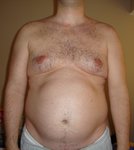i think myth means "myth" = not true. G8R is telling him that those things are not true. or not! lol, when i also consider myth #1, it is actually true.
hmmmm RICH!!! did you copy and paste something? splain yerself bruda!
DEF- somtimes you scare me. lol! You read everything! :luxlove:
Todd, I'll explain for you because you're my bud.
Myth 1. No debate to my knowledge.
Myth 2. Look at this table:
An unfit person to hold 15mph has to perform a
vigorous effort. Go to "Bicycling, 14-15.9mph,
vigorous effort" and it lists 863 kcal/hour burned for a 190# person.
For me, 15mph is a
light effort. This is not a vigorous or even moderate effort for me. It is light. The kcal/hour burned for a 190# person at light effort, i.e., "Bicycling, 10-11.9mph,
light effort" is 518.
So, the fit person to perform the same power (=same speed if all other factors such as wind speed, bike type, etc. are held constant) burns fewer calories than the unfit person which is what I said.
the second myth you propose is not true.. he won't burn that much more.. If he is doing exactly the same as you, with the same resistance, etc, he will use largely the same amount of energy as you do (the variation will be due to exercise economy)
It's a lot easier for you to do it since you're trained, but you will be burning the same amount of cals.
If it's a lot easier for me because I'm trained, then why am I burning the same amount of calories as the unfit person? How can one person be having an easier time than another yet they are both burning the same number of calories? Calories measure the heat generated. If one person is generating more heat, he is burning more calories. Period.
Myth 3: See
In this example, the 130# woman burned
82 kcal of fat / 30 min at 80 - 85% of MHR and
73 kcal of fat / 30 min at 60 - 65% of MHR (the so-called fat burning zone).
In short, harder effort = more fat burned, which is what I said. I think tjl said the same.
The third myth is not true either. You burn more calories from fat at a lower HR. That's just a fact. Depending on the total times, you might offset the balance, but the proportion is still there. You even mentioned it would be better to do lower intensity at the end, which completed contradicted your first statement.
A person in poor shape does not have enough endurance to exercise at a high intensity long enough to have significant fat-burning benefit. For an unfit person, he is better off going at a moderate pace than a high pace until he can build up his endurance, even though this does not yield the highest rate of fat burning.
Right, but that's not what he said. He said you burn more fat at higher intensity, and that's not true (see below)
See my above.
At higher intensity, it is completely time dependent.
Fat calories burned result from two factors; intensity and time, not just time. And this is true at lower intensity too.
And no one can do the same duration of exercise at a high intensity than they can at moderate.
This is true and is one of the few reasons to go at a lower intensity than high intensity.
And this doesn't take into account the greater EPOC from the higher effort. The difference should be even greater.


